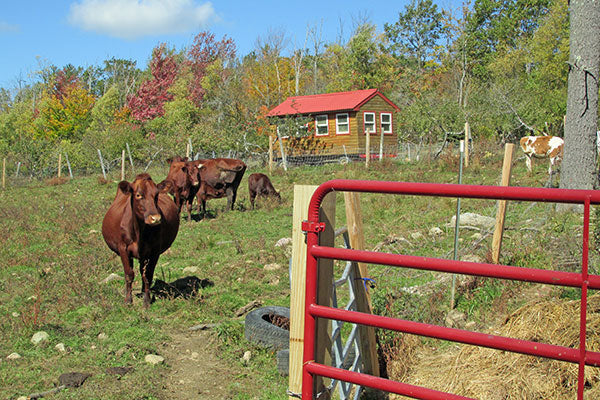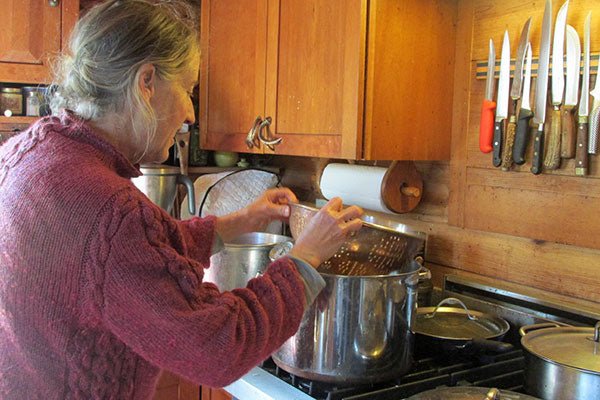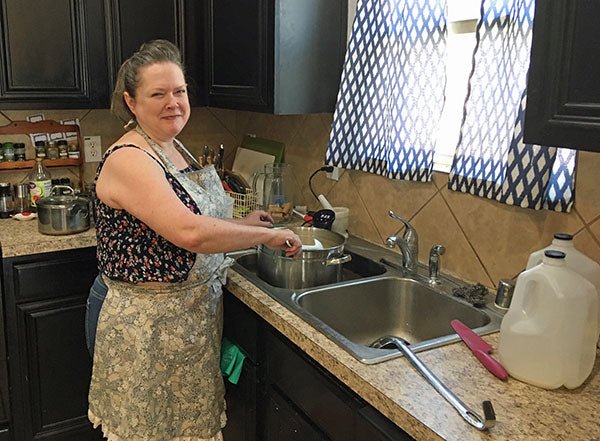
Brigitte Ruthman, dairy farmer and investigative reporter
It’s rare that I get to interview a cheesemaker in person, particularly during this pandemic. But, it was a beautiful drive to the Berkshires in Western MA and I found Brigitte’s log cabin high on a mountain at the end of a dirt road with no other signs of civilization in sight.



Her garden

You can see her apple orchard behind her garden.
She invited me in and I couldn’t help but notice her cheese on the counter. I had heard about it in e-mails, so I knew it was a fresh, lemon cheese.


She was in the process of making another batch. (Yay!)

While we waited for the rennet to set, she showed me the house she had built herself. (Isn’t it perfectly normal for a woman to build her own log cabin in a remote area at the edge of a state forest?)

It’s a “kit” house. The kitchen and living area are open in this huge space with a high ceiling. The antlers on the wall testify to her skill as a bow hunter.
This past February, Kai Ryssdal did a short piece on NPR about her house: https://www.marketplace.org/2020/02/19/building-a-house-one-log-at-a-time/

These doors are beautiful and this photo doesn’t begin to do them justice.

There are skins of animals she has trapped hanging near this fireplace.

The sign was found at the Brimfield Flea Market around 20 years ago. It had once hung over the meat market in Torrington about a mile from where Brigitte works her day job.

View from her bedroom

Tiling by Brigitte, of course

Kitchen and make room
Brigitte had always wanted to live in a log cabin and to milk her own cows. Her father had been a dairy farmer in northern Wisconsin. He had met her mother when he was stationed in Germany during the Occupation and he brought her back to this country. As a child, Brigitte pretended to be cutting hay and transporting it with her toy wagon.

Left to right: Brigitte’s father, his parents and his brother Richard. Her mother at right.
In 1978, she worked on a dairy farm in Northern Vermont – when she was between high school and college. She became the herdsman while the owner was building a barn.
She learned about the importance of weaning a calf at 4-5 months and no earlier. She developed her own method for raising happy, healthy cows who would be good parents themselves when they matured.

Brigitte is currently milking 4 out of her herd of 9 Jersey/Shorthorns.
Making a Living
Her career has always been journalism, as it is now. After she graduated from the University of Connecticut, she worked – first at The Lakeville Journal, a weekly newspaper in Salisbury CT, then at The Burlington Free Press capital bureau in Vermont as a regional reporter.
Since then, she has worked for The Republican American (newspaper) for 31 years, covering all sorts of beats and serving as bureau chief for the Northwest Corner of CT.

To see 903 of Brigitte’s articles – click here.
All the while, she was involved with farms part time. She lived (rented) and helped out for 14 years at a large farm in Salisbury where the dairy had made way for beef cattle/sheep, etc.
She couldn’t stay in the NW Corner to buy property because of the expense. Sandisfield is just a half hour north.

Brigitte’s cheese
Brigitte’s Cheese
Brigitte makes a fresh cheese and she shared her recipe with us:
This cheese is based on a mozzarella recipe, but it uses lemons for citric acid, and New England Cheesmaking Supply (cheesemaking.com) vegetable rennet tablets. It melts.
I use fresh raw milk, and have found that letting it chill a little bit makes the curds more firm.
Recipe:
Add the juice from two lemons to a large pot with two gallons of milk, one lemon per gallon.
Let that set for 10 minutes, then slowly heat on an oven burner to 100F.
Dissolve an entire vegetable rennet tab in about a quarter cup of water and stir it slowly into the milk. (It has to be well dissolved when you add it to the milk.)
Take the pot off the heat, cover it and let it set for 15 minutes.
Cut the curds.
Reheat it slowly to 110F (I find its okay to reach 120F).
Using the very fine NECS skimmer, transfer the contents to a metal colander to drain. Turn it gently but don’t work it. Let it drain for 30 minutes or more.
You’ll end up with a loaf of cheese, lemony in flavor. It can be used like a feta on salads or to melt over baked dishes. It’s perfect with tomatoes and bruchetta, basil and a nice glass of wine.




Lemons in the colander


Beautiful curds

Draining the curds through the colander (no cheesecloth needed!)




Brigitte doesn’t add salt to the cheese when making it because she wants the flavor of the milk to come through.

Sun-dried tomato tapenade
Her Press
Someday soon, Brigitte will be making aged cheese with her Dutch style press.

The Milk
Brigitte offers herdshares for folks who want raw milk. Her customers bring their own bottles and they fill them from the milk tank themselves. They clean the filter in the tank when they’re done.


She has 2 bulk tanks – one is a 15 gallon tank and the other holds 33 gallons. These are small versions of the larger commercial tanks which keep milk circulated, and thus fresher. (As soon as you put milk into a container, it will separate its components and begin to age.)
She uses the smaller tank during the late winter and early spring when the cows are toward the end of their lactations and there is less milk (or for overflow). The bigger tank is in use now with four cows fresh from May-July.

33 gallon bulk tank

15 gallon bulk tank

Brigitte showed me how she skims the fat off Rosemary’s milk. Rosemary is half Jersey and half milking Shorthorn. She is A2/A2 (beta-casein). Her milk is creamy but not excessively so, and high in protein.



She makes her own butter from the fat she skims off. The chickens eat the skimmed milk.

She usually uses her blender to make butter, but sometimes this separator comes in handy.
The Tour

The barn where the cows are milked

The “Palace” for the chickens

She stores her hay in this barn.

Grain bin

One of 3 chicken houses

Feeding station
Brigitte has been breeding (for six generations) cows with a focus on the “three D’s” in mind- demeanor, durability and digestibility. She told me that means only friendly, well behaved animals, able to thrive on her sometimes brutal New England hillside and produce desirable beta casein creamy milk, have a reservation in the stanchions.



With Sapphire

Baby Genevieve, a Guernsey


In addition to her cows, Brigitte has 280 hens and assorted roosters (at last count).

She raises Freedom Ranger broilers in a movable Amish chicken tractor enabling them to forage on grass.
She sells the eggs at Guido’s Market in Great Barrington. Her eggs are in great demand and the chefs love them because she feeds her chickens milk and that gives the eggs a creamy flavor. (I can testify to that, having left her farm with a dozen absolutely delicious eggs.)



The eggs are huge!















































































































































